Lifecycle Management
• 9 min read
5 Key Questions to Ask While Choosing a User Lifecycle Management Tool
27th April, 2023
SHARE ON:
Choosing the right user lifecycle management (ULM) tool can be challenging, as many options are available in the market. It requires a thoughtful evaluation of your goals and budget and product functionalities, scalability, integrations, and more.
Though the benefits of a ULM tool can sound compelling, it can be exhaustive when you look for a ULM tool that fits your specific IT teams' requirements.
The right ULM tool in place provides IT admins with a centralized platform to manage user data, and automate tasks, reducing the likelihood of errors and increasing efficiency. Besides, the benefits aren't limited to providing or modifying user access, but it speeds up the process, prevents data vulnerability, and enhances the productivity of both employees and IT teams.
Having a checklist will help you match your requirements with the product features to select the best ULM tool for your IT teams.
Questions to Ask Yourself While Choosing a User LifeCycle Management (ULM) Tool
Consider the following factors to unlock the full power of the user lifecycle management tool.
1. What level of granularity does it provide on SaaS apps & users?
IT admins require a granular view of employee activity from the day they are onboarded to the day they are offboarded in an organization. Having a granular view of employee activity allows IT admins to ensure that new employees are properly onboarded onto the organization's network and systems.
This includes setting up new accounts, granting appropriate access to different applications and systems, and ensuring that employees have the necessary SaaS apps to perform their job functions. Without a granular view of these activities, IT admins may overlook critical steps during the onboarding process, which could lead to security vulnerabilities or productivity issues.
With a granular view, IT admins can optimize SaaS app allocation and improve productivity. By analyzing employee usage patterns, IT admins can identify areas where SaaS apps may be underutilized or overutilized and adjust accordingly. This could include reallocating licenses or implementing new apps to improve efficiency.
Moreover, a granular view of employee activity is crucial during offboarding. IT admins must ensure that departing employees can no longer access the organization's systems and data.
By closely monitoring employee activity, IT admins can quickly identify and revoke access to any systems or applications that are no longer necessary, reducing the risk of data breaches or other security incidents.
Thus, IT admins should ensure that the ULM tool they choose provides granular SaaS app usage data. In addition, the tool should be able to collect in-depth usage data from different SaaS apps used in the organization and present it in an easy-to-understand format.
By doing so, IT admins can quickly identify areas that require attention and make data-driven decisions when managing users' lifecycles effectively.
Are you wondering if any ULM tool provides a granular view? Thankfully, yes. Zluri offers a lifecycle management platform that helps IT admins achieve greater granularity in their SaaS app usage inputs.
By collecting and analyzing data on how SaaS apps are being used across an organization, Zluri provides valuable insights to help IT admins make more informed decisions about their app usage.
Zluri helps IT admins understand how the employees are using apps in detail. For example, instead of just knowing how many people are using a specific app, IT admins can find out which parts of the app are used the most, which teams use it the most, and how much time is spent using it each day, week, or month.
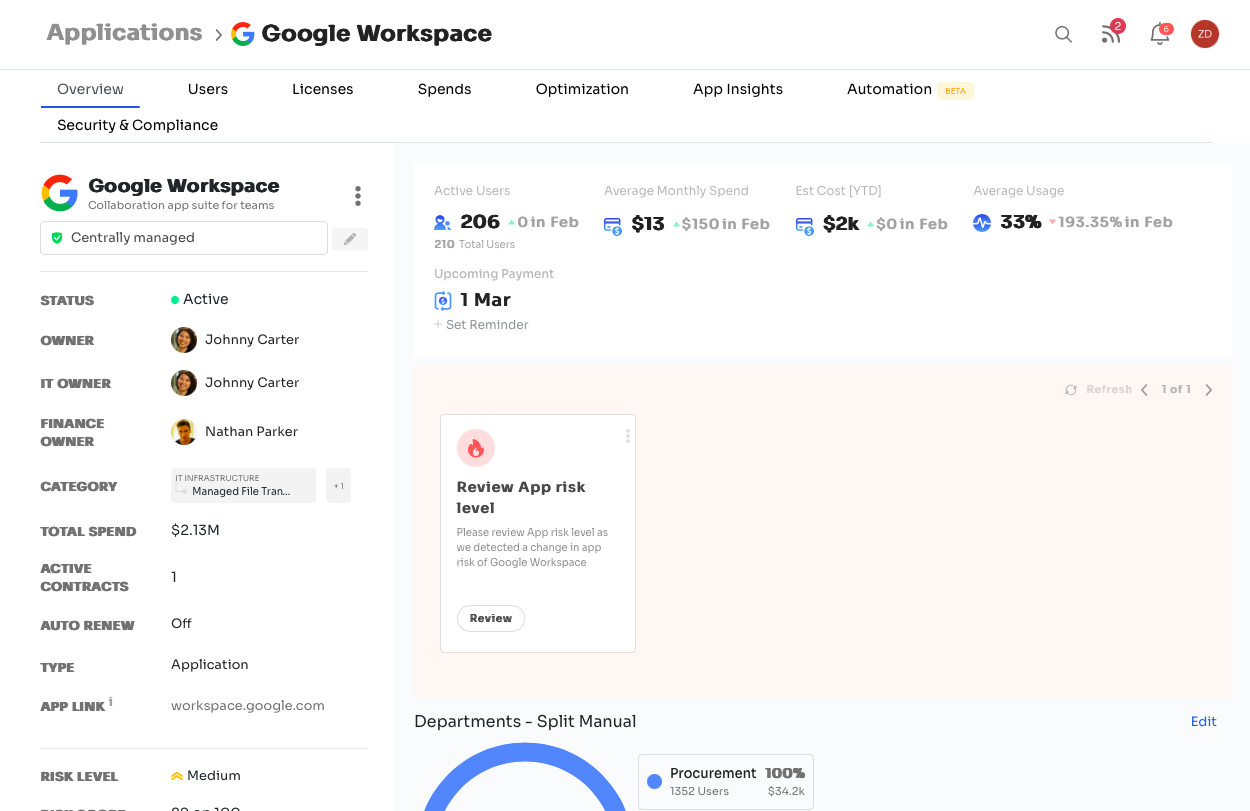
In addition, Zluri helps IT admins more effectively manage their app portfolios, troubleshoot issues, and ensure that apps are being used in a way that aligns with organizational policies and security standards.
For example, suppose Zluri detects that a particular app is being used in a way that is putting sensitive data at risk. In that case, IT admins can quickly take action to address the issue and enforce more robust security protocols.

Also, Zluri helps you stay secure and compliant with ISO 27001, SOC 2, GDPR, and more compliance frameworks. Such compliance enforcement framework platforms protect the apps or their users from falling prey to any threats posed by internal and external organizational factors.
2. Can it help you audit your SaaS stack to identify hidden SaaS risks?
Choosing the right user lifecycle management tool is crucial for IT admins to manage users within an organization effectively. One key factor that should be considered while evaluating user lifecycle management tools is auditability. Auditing user activity and changes made to user accounts are essential for maintaining security and compliance within an organization.
An audit trail records all actions taken on a user account, allowing IT admins to easily track changes and identify potential security threats. By using a ULM tool with strong audit capabilities, IT admins can gain visibility into user activity and ensure that user accounts are being managed in accordance with company policies and industry regulations.
For example, if a user tries to access sensitive information that they shouldn't have access to, the IT admin can quickly identify the issue and take corrective action.
Furthermore, by tracking user activity over time, IT admins can identify patterns and trends that may indicate a need for additional training or support. For example, if multiple users consistently fail to comply with a particular policy, it may be necessary to provide additional training or adjust the policy to make it more manageable.
Also, the tool should allow customization of auditing rules, so IT admins can set policies and monitor user activity that aligns with their unique organizational needs.
Additionally, auditability can help IT teams achieve compliance with various regulatory requirements, such as HIPAA, GDPR, and SOX. IT admins can quickly demonstrate compliance and respond to any audit inquiries by maintaining a detailed audit trail.
Are you worried if your tool helps you track user activities? Need not worry! Zluri will help you with this.
Zluri's auditability capability makes it a suitable option for IT admins looking for a ULM tool that provides full transparency and traceability. It allows IT admins to retrace all the users' actions within the organization.

By tracking user activity, from user logins to file downloads, IT admins can identify trends, patterns, and areas for improvement. This information can be used to optimize business processes, improve user experience, and enhance overall productivity.
3. Does it integrate with your existing SaaS stack for a smooth data flow?
In the past, IT admins used traditional methods like spreadsheets to manage user onboarding and offboarding, but these methods could have been more convenient, time-consuming, and prone to errors. IT admins had to manually enter data into the spreadsheet and keep it up-to-date, which was challenging.
Additionally, spreadsheets did not provide a centralized view of users, which made it difficult for IT admins to manage user accounts, roles, and permissions. As a result, it led to data inconsistencies and errors, affecting the accuracy of user information. Further, resulted in longer onboarding times, increased support requests for apps, and a higher risk of security breaches.
For example, giving an employee incorrect access permissions could lead to unauthorized access to sensitive data. Similarly, forgetting to revoke access to certain applications could lead to continued access to sensitive data even after the employee has left the organization. This could result in security breaches, compliance issues, and legal liabilities for the organization.
Thus, with integration capability, IT admins can automate user onboarding and offboarding processes and access management, making it easier and faster to manage user accounts.
Also, IT admins can create a centralized dashboard that displays all user information, such as access rights and activity logs, making it easier to track user behavior and ensure compliance with organizational policies and regulations.
Moreover, IT admins must consider the existing applications in use within the organization and ensure that the ULM tool can be easily integrated with them. Choosing a user lifecycle management tool that cannot combine with other software applications can result in data inconsistencies, errors, and delays in managing user accounts.
Zluri's integration capability is a key feature that makes it a suitable option for organizations looking to streamline their user lifecycle management processes. With the ability to integrate with a wide range of tools, including HR systems, productivity tools, communication platforms, and more, Zluri provides a unified view of all your SaaS applications in one place.
By integrating Zluri with your existing systems, you can improve visibility into user activity and enhance your security posture. Also, it ensures that your user data is synced across all your systems, eliminating the need for manual data entry and reducing the risk of errors.
In addition, Zluri's integration capability enables IT teams to automate their user onboarding and offboarding processes.
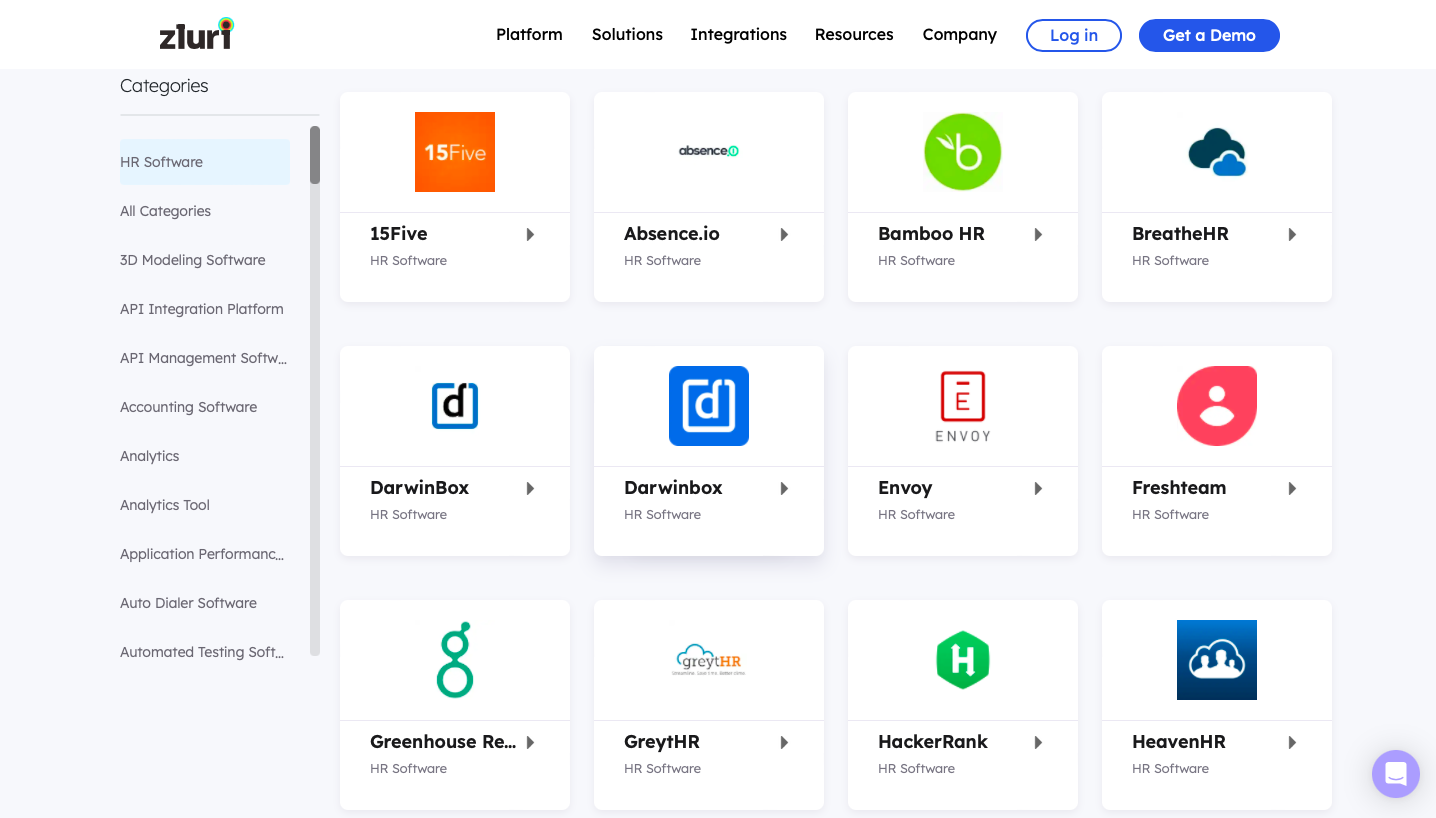
4. Does it have the automation capabilities to enhance the productivity of your IT teams?
In any organization where efficiency and productivity are key, automated capabilities like provisioning and deprovisioning are crucial for managing users' lifecycles in organizations.
Provisioning is the process of creating user accounts and assigning them the necessary privileges and access rights. When done manually, it is a time-consuming and error-prone task, leading to security vulnerabilities and delays in onboarding new employees.
However, with an automated provisioning process, IT admins can create new user accounts quickly and efficiently, saving time and reducing errors.
On the other hand, deprovisioning involves removing user accounts and access privileges from the system when they are no longer needed. For example, when an employee leaves the organization, it can leave security vulnerabilities in the system if manually deprovisioned.
Nevertheless, automated deprovisioning helps IT admins quickly remove user accounts and access rights, reducing the risk of security breaches.
Moreover, automated provisioning and deprovisioning ensure that users have the right access privileges at all times, reducing the risk of unauthorized access to sensitive information. Additionally, it helps IT admins to streamline user management processes, reducing the time and effort required to manage user accounts manually.
Therefore, automated capability should be a crucial point to consider when choosing a user lifecycle management tool. A tool with robust automated capabilities can help IT admins to manage user accounts and access rights efficiently, reducing the risk of security vulnerabilities and improving productivity.
Are you worried about automation in a ULM tool? Zluri empowers IT admins to streamline organizations' user lifecycle management process. With its suite of automated capabilities, Zluri takes the hassle out of managing users, ensuring that your organization can operate smoothly and efficiently.
Zluri's automated onboarding process ensures that new users are quickly granted access to the applications they need to do their job. The process is straightforward and efficient, allowing IT admins to save time and resources. By automating this process, Zluri ensures that users can get up and running quickly and reduces the risk of human error.
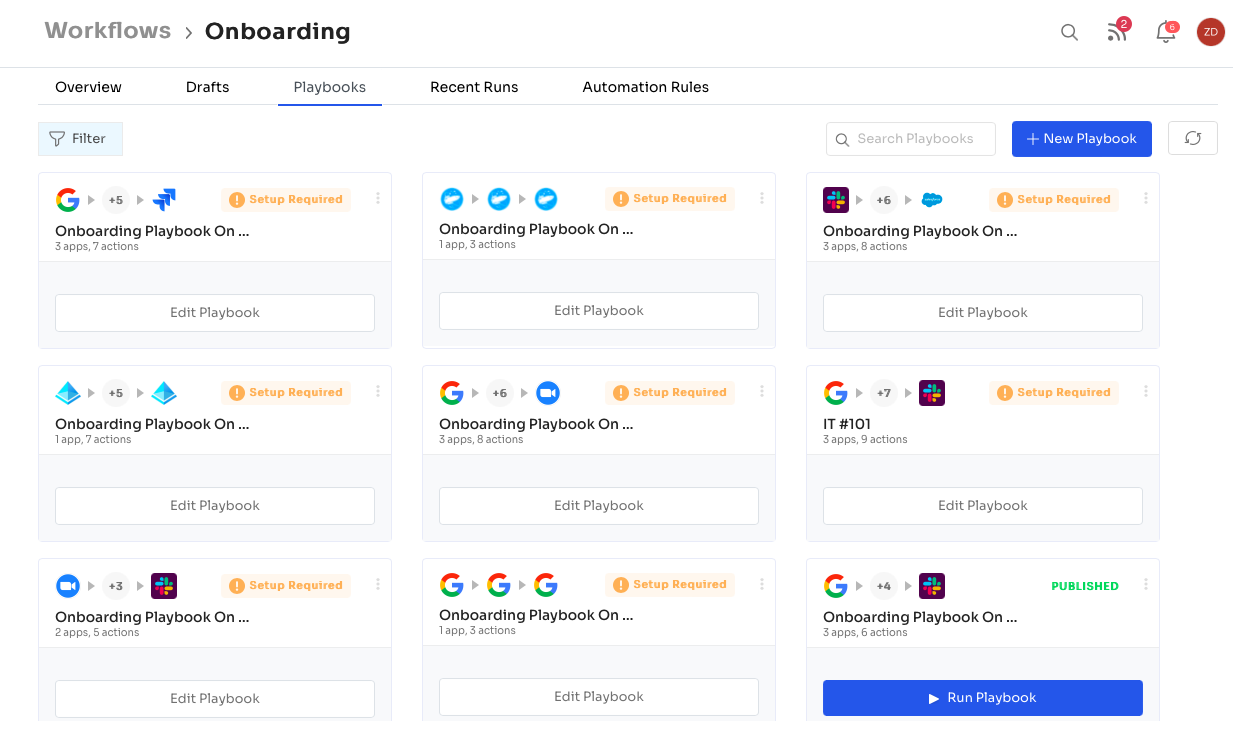
Zluri helps IT teams create custom workflows for their user onboarding process that is based on contextual app recommendations, making it more efficient and effective. Further, it provides in-app suggestions to IT teams, and these suggestions are based on the user's role, department, and other relevant factors like the employee's seniority level.
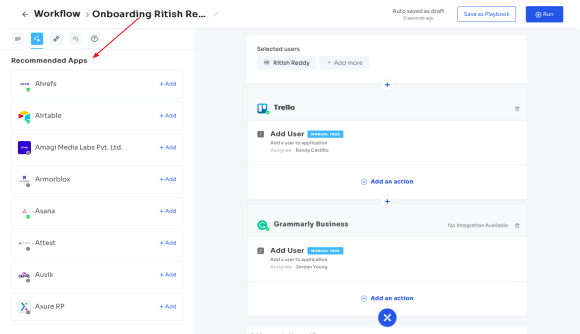
Further, the workflows created in Zluri can be saved as "playbooks," which can be reused in the future. With a list of playbooks, IT teams no longer have to waste time performing the same tasks repeatedly and can instead focus on more critical and strategic initiatives.

Similarly, when offboarding users, Zluri ensures that access to all applications is immediately revoked, minimizing the risk of security breaches. The process is automated, making it easy for IT admins to manage and reducing the risk of errors that can lead to data leaks.
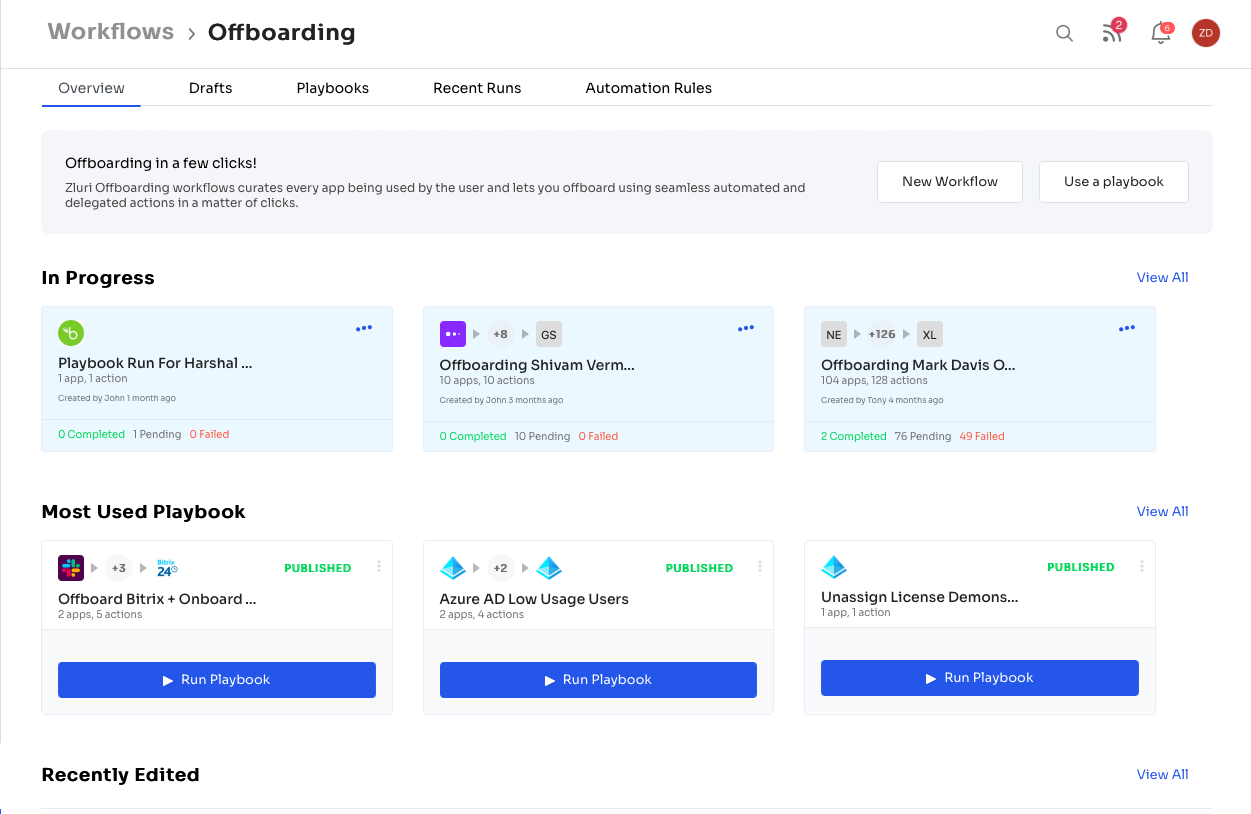
Moreover, with its automation capabilities, Zluri helps organizations operate more efficiently, saving IT admins time and resources while reducing the risk of errors and security breaches.
5. Whether it has automated actions to streamline your user lifecycle management process?
As organizations grow, the number of users that IT admins are responsible for managing also increases. This can be time-consuming; as a result, IT admins need automated actions to streamline their user management process.
Automated actions are predefined workflows that help IT admins automate routine tasks and reduce manual efforts. For instance, automated actions can be used to automatically create or delete user accounts, update user data, grant or revoke access to applications, and enforce security policies.
These actions can be customized to meet the specific needs of an organization. Customizable workflows allow IT admins to define a set of rules for different stages of the user lifecycle, such as onboarding, offboarding, and more.
The rules can be customized based on an organization's policies, regulations, and industry standards. For example, workflows can be designed during onboarding to collect user data, assign roles, and grant access to necessary applications. Similarly, during offboarding, workflows can be designed to revoke access to applications, delete user accounts, and remove user data from the system.
The customizable workflows not only save time and reduce manual efforts, but they also ensure accuracy and consistency in user data management. Moreover, it helps IT admins comply with regulatory requirements and security policies.
Choosing a user lifecycle management tool with customizable workflows is crucial for IT admins. This helps IT admins manage users' lifecycles effectively, reduce errors and delays, and ensure compliance with industry standards. Moreover, it helps IT admins focus on strategic initiatives rather than spending time on routine tasks.
Therefore, a ULM tool like Zluri offers customized workflows to meet your organization's unique requirements. With its flexible and customizable workflows, Zluri ensures that IT admins can efficiently manage SaaS applications and their users and streamline organization operations.
For example, with Zluri, IT admins can create a customized workflow for provisioning the right tools to the right users at the right time in organizations. This capability ensures that users have access to the right applications based on their organizational roles and responsibilities.
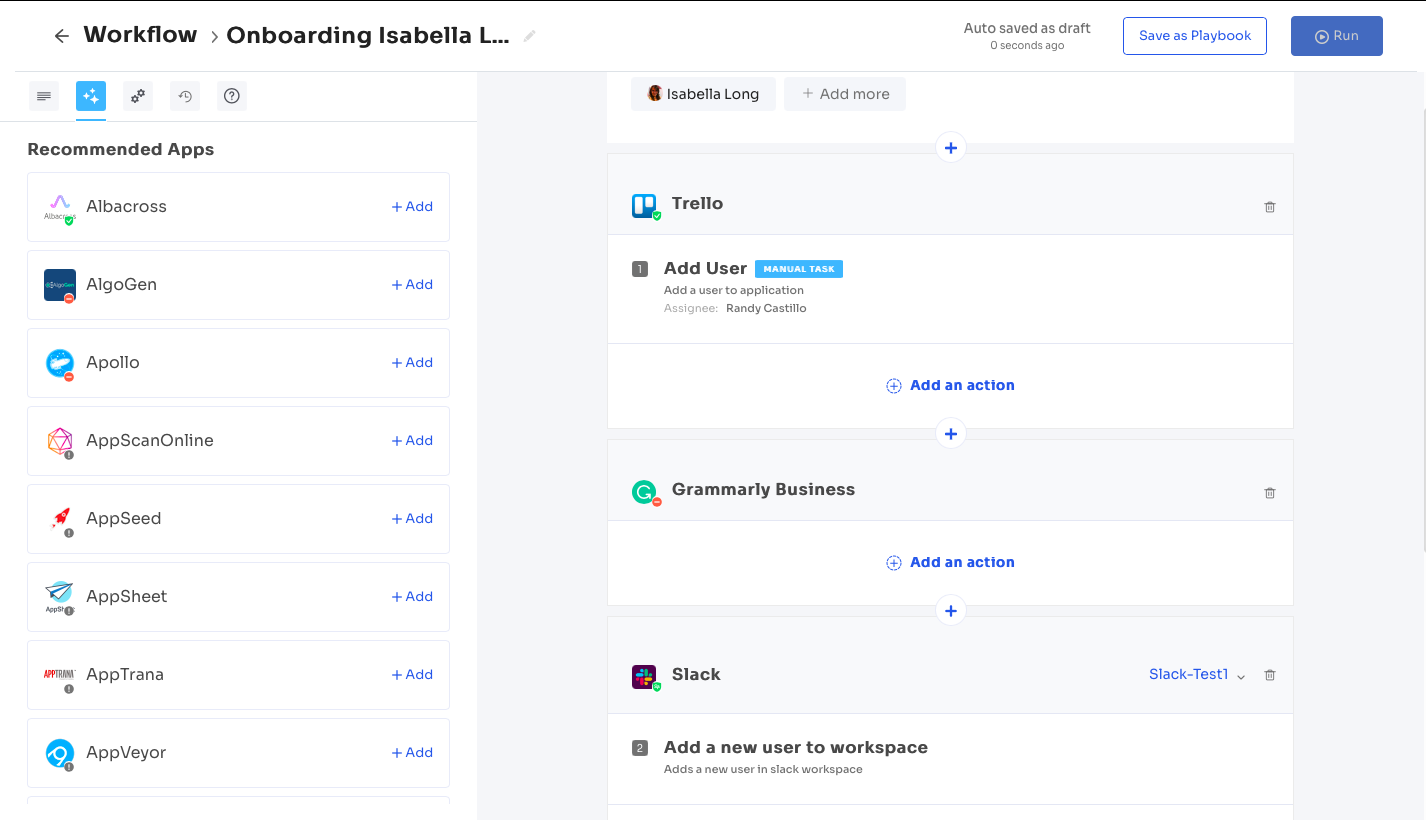
This workflow can be saved as a "playbook" for future use, helping IT admins automate their repetitive tasks of provisioning users with similar roles and seniority levels.

Also, with Zluri, you can create customized workflows for a wide range of use cases like offboarding employees, managing license renewals and cancellations, automating security and compliance checks, etc.
Opt for Zluri to Automate User Lifecycle Management
Zluri is a powerful user lifecycle management tool that IT admins should consider when looking for a solution to manage their users across their entire lifecycle. One of the key benefits of Zluri is its automation capabilities, allowing IT admins to automate routine tasks like onboarding and offboarding, reducing the risk of human error and streamlining the user management process.
Another key advantage of Zluri is its focus on security. We provide you with the security details for each application used in organizations. This ensures that IT admins can manage their users with confidence and trust that they are using secure apps where the organization's data is protected.
Also, Zluri stands out in the market for its ease of use. The tool has a user-friendly interface, allowing IT admins to work efficiently. Additionally, Zluri offers seamless integration with other tools, including directory services, SSO solutions, and more, making it easy to manage users adequately.
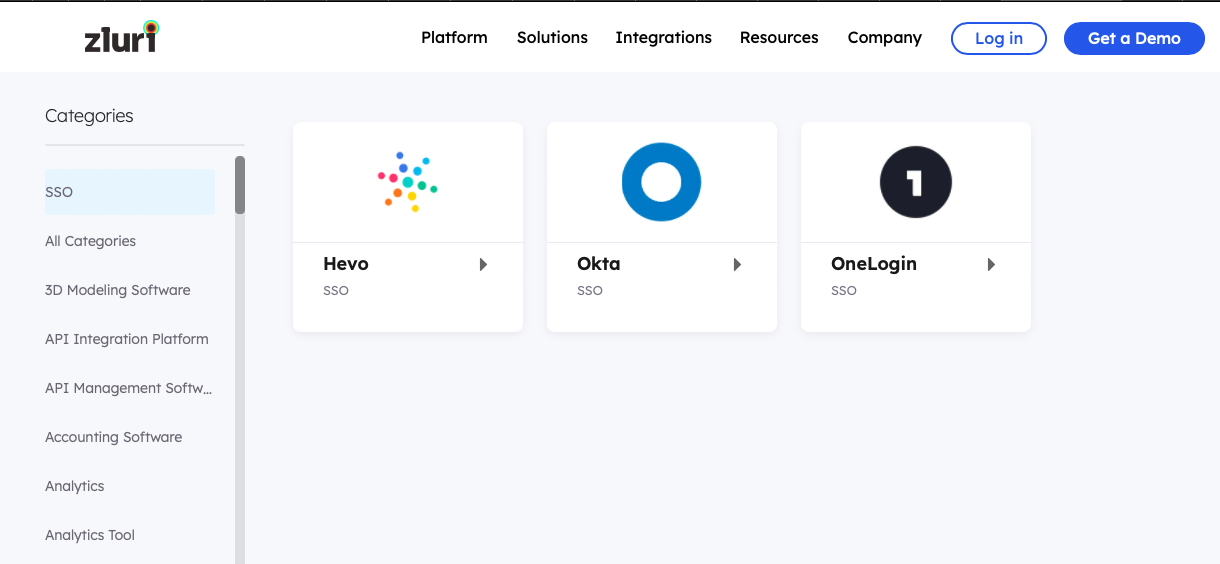
Further, Zluri provides usage data that helps IT admins track user behavior and their interaction with the apps in organizations. This data-driven approach allows IT admins to make informed decisions and improve their overall user management practices.
To explore more about Zluri's user lifecycle management, schedule a demo today!
About the author
Sethu is the Co-founder of Zluri. He believes SaaS and APIs will help everyone become a builder. He frequently writes on SaaS management and workplace automation. Before Zluri, he was part of the founding team at KNOLSKAPE, one of the leading corporate learning gamification startups that he helped scale across 30 countries. Other than technology, Sethu is passionate about quizzing, board games, and photography. His retirement plan is to operate a board game bistro in one of the touristy spots of Southeast Asia.
Related Blogs
See More
Subscribe to our Newsletter
Get updates in your inbox
